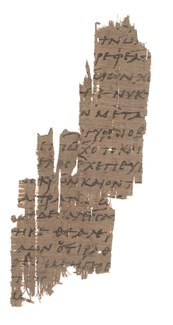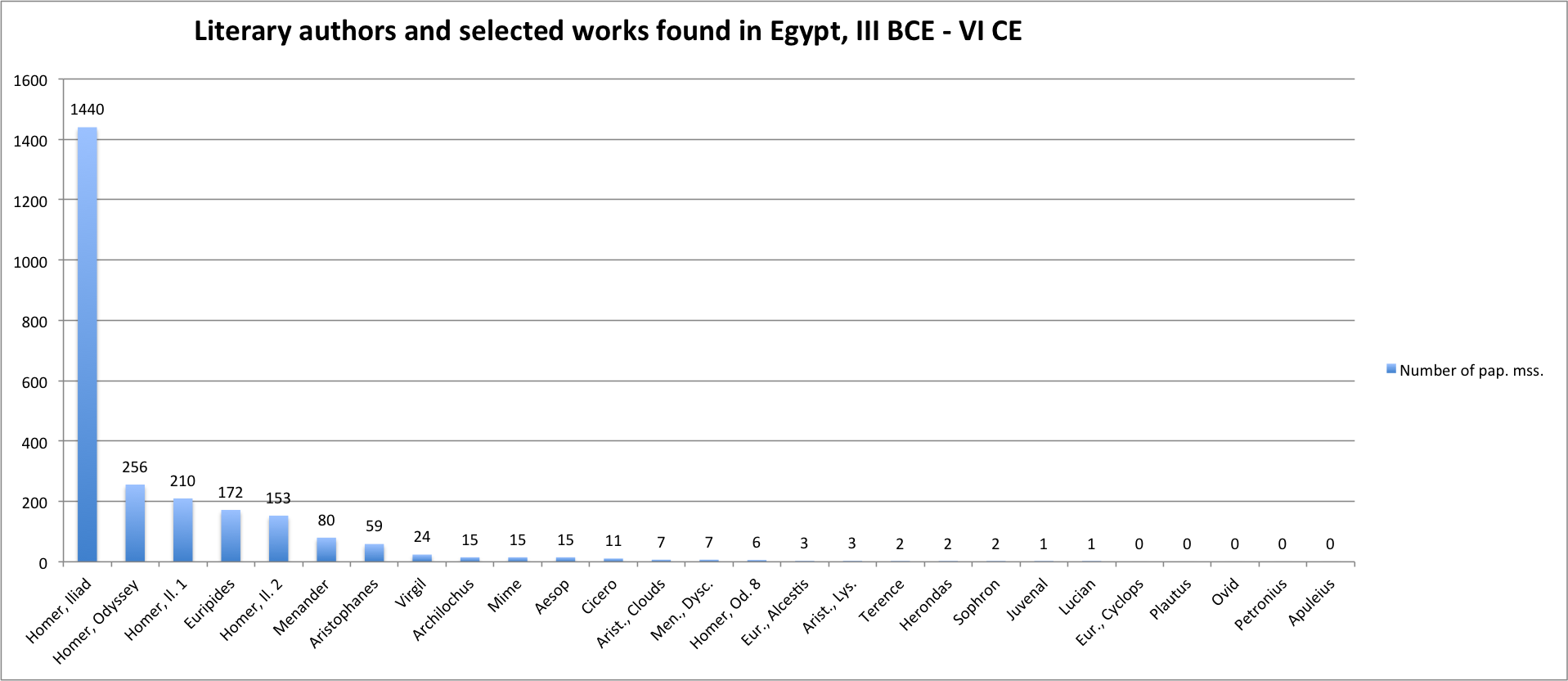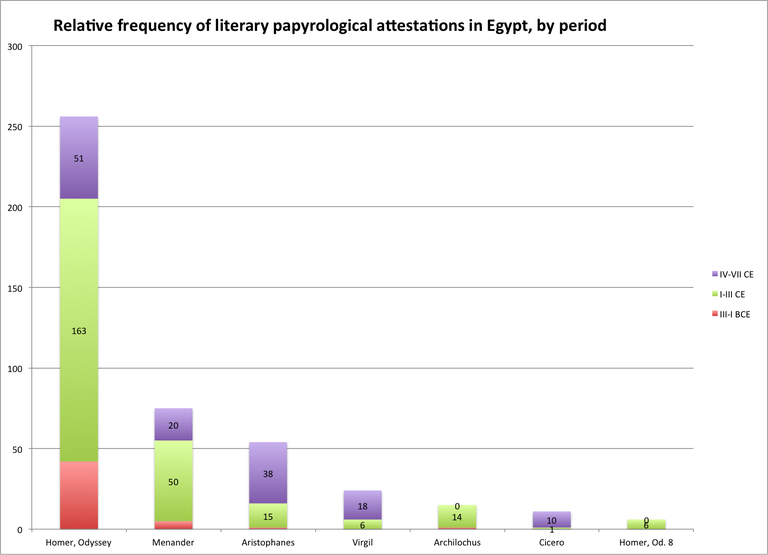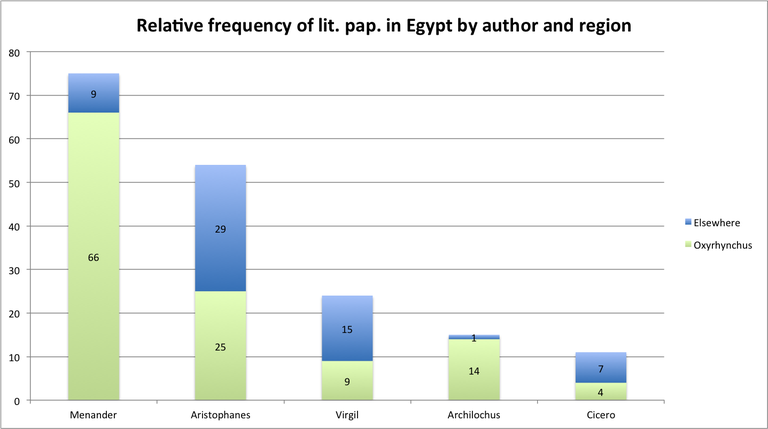Is there anything funny about papyri? PART II: Did people read to laugh in Greek and Roman Egypt?
Being a librarian and a papyrologist, I have always found the possibility of learning about ancient reading preferences and habits from papyri intriguing. So, I naturally decided to take the opportunity presented by my friend Mathias's challenge to find humor in the papyri to see if I could determine the place of humorous literature in the reading culture of Greek and Roman Egypt.

Papyri allow us to explore the relationship between readers and texts from several possible angles. For instance, we can understand something of the way texts were actually read from marginalia, glosses, and accents--all added to aid comprehension and recitation (see the recently-published fragment of Homer, left). In studying ancient reading, however, it also pays to remember that we rarely get to see ancient readers in the full spectrum of their literacy: we usually have evidence of either (elite) literary engagement or (sub-elite) documentary practice. Of course, there is no reason to doubt that most, if not all, readers of literature were involved in both types of literacy. Cicero or Pliny the Younger clearly read both books and documents, being not only educated gentlemen and authors, but also wealthy landowners, lawyers, and provincial governors; yet we can only see this indirectly from their correspondence. Much the same may be said of the anonymous owners of our papyrus literary manuscripts, which come from the sites that preserve documentary papyri: only rarely do we have any sense of what relationship, if any, particular literary manuscripts have to particular documents.
Sometimes, however, we do get the opportunity to learn about the precise social milieu or personal preferences of an individual reader through his texts, when they can be connected to specific archaeological or archival contexts. Dioscorus of Aphrodito is the classic example. Dioscorus was a sixth-century notary from the village of Aphrodito between Lycopolis and Panopolis in Middle Egypt. Discovered in 1905, his papers constitute a revealing lens into the literacy and education a well-to-do Byzantine provincial who spent part of his career in what we might call the civil service. As befits a landowning notary, we find in his papers (and by his own hand) various legal documents in Greek written on behalf of villagers, his family, and himself, as well as our first such Coptic documents. We also have some literary manuscripts from his library. We know, for instance, that he owned a small collection of comedy, including manuscripts of Menander. We even have classicizing poetry written by Dioscorus himself! The ability to compose such poetry was very much an important marker of paideia in the sixth century and Middle Egypt produced some very famous poets in the two centuries leading up to Dioscorus’ time, like Nonnos of Panopolis. As for the poetry ... let's just say it was a good thing that Dioscorus stuck to his day job.
The problem presented by Dioscorus, and papyrus finds more generally, is the question of typicality: how typical was Dioscorus in his enjoyment of comedy? How sure are we that we have his entire library or that he even read what he owned? (Have you read every book in your house, and even if so, for the same reasons or in the same way?) We may extend this line of questioning to all the ancient manuscripts we have: how typical are our surviving literary papyri of ancient reading preferences in Egypt or more widely? Can the relative frequency of texts tell us something about popularity, and if so, what? How different are those ancient (Egyptian?) preferences (assuming we can discern them) from our own? Finally—and getting back to ancient humor—can we say anything specific about an ancient (Egyptian?) interest in humor from an analysis of the survival pattern of literary manuscripts?
I explored precisely these questions during my visit to Mathias’s class at Penn State.
First, I asked the students to pick their favorite authors or texts thus far on the syllabus, which at that point were:
- Homer, Iliad 1-2; Odyssey 8
- Archilochus
- Aristophanes, Clouds, Lysistrata
- Euripides, Alcestis, Cyclops
- Menander, Dyscolus
- Plautus, Menaechmi, Amphitryo, or Pseudolus
- Terence, Eunuchus
- Ovid, Metamorphoses
I then asked them to rank three of these texts in order of popularity. This was obviously not a scientific poll, but it was still illustrative, as several students ranked Odyssey 8 highly--and what's not to love about the scene of the ensnaring of Ares and Aphrodite in the Song of Demodocus, right?
Next, I showed them the relative survival of the texts on their syllabus from Egypt:

Well, that's a bit shocking! There are more copies of Iliad 1 than everything else combined! And not a single Latin text of those that they were reading has been discovered in Egypt. (If you want to explore this sort of thing, I suggest checking out the Mertens-Pack 3 database from CEPOPAL, though you will want to cross-reference the data there with the sometimes more up-to-date information in Trismegistos). Upon reflection, these results are perhaps not so surprising: we know that Homer was popular and that even in Roman Egypt, the period from which we have the most published papyri, the literary (and administrative) culture was firmly Greek.
But perhaps we should expand the context a bit more:

Wow, the attestations of the Iliad really put things into perspective! Now, that's popular! Clearly, literature consumption in Greek and Roman Egypt obeyed the power law of the long tail.
It needs to be said that many of those attestations are not manuscripts per se, but student exercises--but that is part of the point: the Iliad was a school text in the way that even the Odyssey or the plays of Euripides were not; yet both the Odyssey and the plays of Euripides were popular school and reading texts in a way that Herondas or Archilochus were clearly not. Furthermore, if you drill down into some of the categories above to see the frequency of particular books or plays, you will find that the distribution is not even internally either, i.e., as with Homer, certain books or works are clear favorites, like Books 1 and 2 of the Iliad, which together account for approximately one quarter of published attestations of the Iliad.
Returning to humor, it is perhaps sobering that just 6 manuscripts of Odyssey, Book 8 have been published. We do have several papryi of satyr plays, but not one of Euripides' Cyclops (against 3 of the Alcestis and (not noted above) 29 of the Phoenissae). Menander appears to be 35% more popular than Aristophanes, but one may wonder, given the general pattern illuminated above, if this has more to do with the relative simplicity of Menander's Greek and his universal brand of situational comedy than with a true comedic or literary interest. Finally, while Virgil, Cicero, Terence, and Plautus were all standard school texts in the Latin West, it is seems clear that the interest in Latin in Egypt was strongly on the epic-rhetoric side, with Virgil and Cicero taking pride of place.
But this raises another question: should we be lumping all these attestations together like this, or do geography and period matter as well?
First, period:

Before proceeding, we have to concede that these numbers are in themselves fuzzy--really just simple orders of magnitude--and reflect some important structural biases. First, they only reflect what is in CEDOPAL (which is pretty good), but I also have to count the attestations by hand (which is hardly error-free). More importantly, dating is by paleography, which is not an exact science. I therefore have to make line-calls when something is dated, e.g. "late 3rd-early 4th." My rule was to select the latest consensus date assigned, since that provided consistency across the data set (even if it pushed the whole set a bit later) and counteracts a possible bias to down-date manuscripts (who doesn't want to find an early witness to a text?). Third, to do this scientifically, you really have to index the finds in each period to the total number of papyri published, so that you can determine what one would expect in the way of a distribution. For instance, if 50% of published papyri were from the first three centuries, you would expect, if literary preferences were stable, 50% of the manuscripts of any one author to come from that period. Even then, there are biases related to publication: literary texts have, in general, received priority in publishing over documentary ones, and certain periods over others, etc. One could conceivably correct for this, and I have not done any of this indexing work (yet).
With all those caveats out of the way, I think the graph above does tell us at least three things:
- Such indexing is necessary: some 64% of Odyssey texts come from the Roman period, compared to 67% of Menander and 28% of Aristophanes, but 90% of Archilochus. Are these differing percentages reflecting relative preferences within periods and changing preferences over time, and if so, what is the baseline? We cannot really say without indexing.
- If, however, we take the Odyssey as some sort of baseline, it is interesting and perhaps significant to note that the relative percentages of Menander over time seem to mirror those of the Odyssey (16-64-20 vs. 7-67-27), but differ from those we find for Aristophanes (1-15-38), which instead appear to track the percentages for Latin texts, e.g., Virgil (0-25-75). Again, for reasons of sample size and lack of indexing, we cannot push this too far, but it suggests that not only was Menander a favorite, he was so in a way that reflects a school tradition; whereas, the manuscripts of Archilochus (7-14-0) might represent a completely different literate phenomenon.
- Finally, as we might suspect, the interest in Latin was a late antique phenomenon. Indeed, what is interesting, perhaps surprising, is just how many examples of Virgil we have from Egypt before the fourth century.
Now, geography:

Looking at this, one immediately perceives the importance of Oxyrhynchus, a nome capital in Middle Egypt, to our ancient literary history: a whopping 65% of all the manuscripts and attestations of these authors come from this one provincial town! Again, we really need to break this phenomenon down by period as well and index it to the relative percentages of finds found at Oxyrhynchus over time (e.g., how many of the late antique vs. Roman Menanders come from Oxyrhynchus, and how do those percentages correlate to the overall finds from Oxyrhynchus in those periods?). Even so, the graph above illuminates some differences not only in the absolute numbers but also in the distribution of Menander against that of Aristophanes (does this have anything to do with the later profile of the Aristophanes mss?). It is absolutely sobering to think that pretty much everything we know about the actual textual transmission and reading of Archilochus before the medieval manuscript tradition comes from Oxyrhynchus, which of course begs the question of typicality. Finally, it is interesting that in this geographic perspective Aristophanes once again looks strikingly like the distribution of Virgil and Cicero: is he reflective of a change of some sort in the educational patterns of late antique Egypt? (Short answer: almost certainly yes.)
Well, what does this say, in the end, about humor?
Humorous texts were less popular than other genres both in schools and in the higher reaches of literary consumption. There is no doubt that comedy and other humorous authors and texts were read, but epic, tragedy, and other genres (many of which I did not explore here) were clearly more popular. Similarly, when Latin did arrive, it was not the entire Western pedagogical cannon, in which Plautus and Terence figured prominently, but only the Latin one really needed to advance in the late antique legal and bureaucratic circles. No Roman laughter, please: we're Greek.
Menander, as we know from literary sources, was indeed a school author, and in fact many of the papyrological attestations come from such a context, e.g., student copies and exercises; lines, maxims, and aphorisms excerpted for memorization (here is a good example from Berlin), etc. Menander's plays tend to be accessible in both language and content, and the themes and messages of the plays generally socially acceptable (that is to say, conservative). All this is to say that the way Menander was read suggests that the comedic elements were, at best, more of a plus than the primary reason. Many, if not most, people, in other words, likely read Menander for a host of reasons other than (perhaps even in spite of) his humor.
I am less certain about the readership of Aristophanes, who is more difficult and more subversive (and funnier), and what the readers of our papyri were getting out of him. In the Roman period, Aristophanes was not really a school author, at least not on the same level as Homer, Euripides, and Menander. Later, interest in Menander does seem to wane, while Aristophanes and Old Comedy become the comedy of choice. Was Aristophanes read for laughs or for his Attic style? Or both, since he is likely to be read at a higher level? Perhaps Aristophanes was really the only classic, canonical literature people read to laugh with any real regularity.
Finally, how Egyptian is any of this? Raffaella Cribiore's Gymnastics of the Mind, esp. chapter 7, places the papyri into a larger context (and is generally an excellent book on ancient education), and from this perspective we may be tolerably sure that Egypt in general and Oxyrhynchus in particular were not completely idiosyncratic: we can match trends, like those we see above, with evidence from elsewhere. While the question of typicality is hard to answer definitively (and certainly not in this forum), it seems reasonable to say that when it comes to the literature of humor, the papyri show Egypt to be participating in the wider Hellenistic and imperial cultural patterns of paideia.
But, perhaps the rolls of an adopted literary cannon is not the right place to look for an Egyptian brand of humor? Then again, it wouldn't be that surprising to find local favorites within the cannon (was the Phoinissae as popular in Antioch as Oxyrhynchus)? Perhaps we need to look a bit harder.
Be that as it may, I will moving on in the next post to epistolary humor and laughter, comparing elite, literary letters to the documentary letters we have that survive from Egypt.